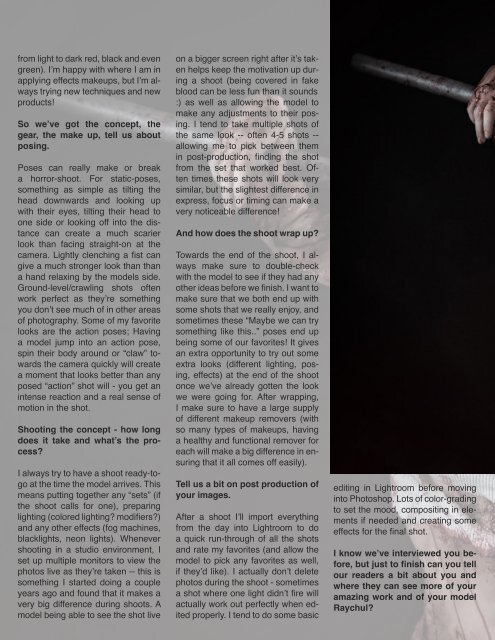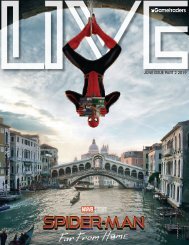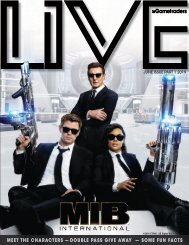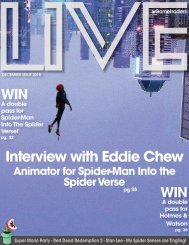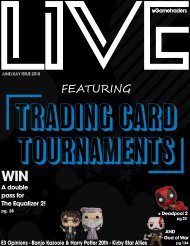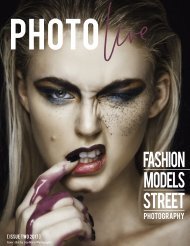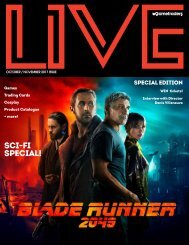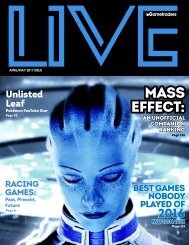October Magazine
Horror time ... if you love horror games, comics and cosplay, you'll love this months issue of Live Magazine!
Horror time ... if you love horror games, comics and cosplay, you'll love this months issue of Live Magazine!
Create successful ePaper yourself
Turn your PDF publications into a flip-book with our unique Google optimized e-Paper software.
from light to dark red, black and even<br />
green). I’m happy with where I am in<br />
applying effects makeups, but I’m always<br />
trying new techniques and new<br />
products!<br />
So we’ve got the concept, the<br />
gear, the make up, tell us about<br />
posing.<br />
Poses can really make or break<br />
a horror-shoot. For static-poses,<br />
something as simple as tilting the<br />
head downwards and looking up<br />
with their eyes, tilting their head to<br />
one side or looking off into the distance<br />
can create a much scarier<br />
look than facing straight-on at the<br />
camera. Lightly clenching a fist can<br />
give a much stronger look than than<br />
a hand relaxing by the models side.<br />
Ground-level/crawling shots often<br />
work perfect as they’re something<br />
you don’t see much of in other areas<br />
of photography. Some of my favorite<br />
looks are the action poses; Having<br />
a model jump into an action pose,<br />
spin their body around or “claw” towards<br />
the camera quickly will create<br />
a moment that looks better than any<br />
posed “action” shot will - you get an<br />
intense reaction and a real sense of<br />
motion in the shot.<br />
Shooting the concept - how long<br />
does it take and what’s the process?<br />
I always try to have a shoot ready-togo<br />
at the time the model arrives. This<br />
means putting together any “sets” (if<br />
the shoot calls for one), preparing<br />
lighting (colored lighting? modifiers?)<br />
and any other effects (fog machines,<br />
blacklights, neon lights). Whenever<br />
shooting in a studio environment, I<br />
set up multiple monitors to view the<br />
photos live as they’re taken -- this is<br />
something I started doing a couple<br />
years ago and found that it makes a<br />
very big difference during shoots. A<br />
model being able to see the shot live<br />
on a bigger screen right after it’s taken<br />
helps keep the motivation up during<br />
a shoot (being covered in fake<br />
blood can be less fun than it sounds<br />
:) as well as allowing the model to<br />
make any adjustments to their posing.<br />
I tend to take multiple shots of<br />
the same look -- often 4-5 shots --<br />
allowing me to pick between them<br />
in post-production, finding the shot<br />
from the set that worked best. Often<br />
times these shots will look very<br />
similar, but the slightest difference in<br />
express, focus or timing can make a<br />
very noticeable difference!<br />
And how does the shoot wrap up?<br />
Towards the end of the shoot, I always<br />
make sure to double-check<br />
with the model to see if they had any<br />
other ideas before we finish. I want to<br />
make sure that we both end up with<br />
some shots that we really enjoy, and<br />
sometimes these “Maybe we can try<br />
something like this..” poses end up<br />
being some of our favorites! It gives<br />
an extra opportunity to try out some<br />
extra looks (different lighting, posing,<br />
effects) at the end of the shoot<br />
once we’ve already gotten the look<br />
we were going for. After wrapping,<br />
I make sure to have a large supply<br />
of different makeup removers (with<br />
so many types of makeups, having<br />
a healthy and functional remover for<br />
each will make a big difference in ensuring<br />
that it all comes off easily).<br />
Tell us a bit on post production of<br />
your images.<br />
After a shoot I’ll import everything<br />
from the day into Lightroom to do<br />
a quick run-through of all the shots<br />
and rate my favorites (and allow the<br />
model to pick any favorites as well,<br />
if they’d like). I actually don’t delete<br />
photos during the shoot - sometimes<br />
a shot where one light didn’t fire will<br />
actually work out perfectly when edited<br />
properly. I tend to do some basic<br />
editing in Lightroom before moving<br />
into Photoshop. Lots of color-grading<br />
to set the mood, compositing in elements<br />
if needed and creating some<br />
effects for the final shot.<br />
I know we’ve interviewed you before,<br />
but just to finish can you tell<br />
our readers a bit about you and<br />
where they can see more of your<br />
amazing work and of your model<br />
Raychul?


